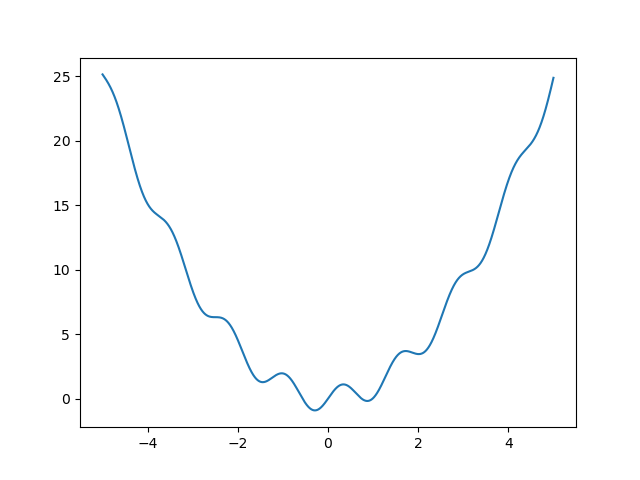目录

模拟退火算法
模拟退火算法(Simulated Annealing)是一种全局优化算法,通常用于求解复杂的非凸优化问题。其基本思想是以一定的概率接受劣解,以避免陷入局部最优解,从而在全局范围内搜索最优解。
步骤
模拟退火算法的步骤如下:

在每个降温周期中,接受劣解的概率随着温度的下降而逐渐降低,从而逐渐收敛到全局最优解。不过模拟退火算法的效果和结果很大程度上取决于初始温度、退火速率和终止条件等参数的设置。
Python实现
下面以求解一元函数 ![]() 的全局最小值为例,演示如何使用Python进行模拟退火算法的实现。
的全局最小值为例,演示如何使用Python进行模拟退火算法的实现。
首先定义目标函数:
import math
import random
def func(x):
return x ** 2 + math.sin(5 * x)
只管看一下该函数的样子:
import matplotlib.pyplot as plt
import numpy as np
xarray = np.linspace(-5,5,10000)
plt.plot(xarray,[func(x) for x in xarray])
定义模拟退火算法
def simulated_annealing(func, x0, T0, r, iter_max, tol):
'''
func 是目标函数
x0 是初始解
T0 是初始温度
r 是退火速率
iter_max 是最大迭代次数
tol 是温度下限
'''
x_best = x0
f_best = func(x0)
T = T0
iter = 0
while T > tol and iter < iter_max: # 判断是否达到停止条件
x_new = x_best + random.uniform(-1, 1) * T # 生成新解
f_new = func(x_new) # 计算目标函数值(适应度值)
delta_f = f_new - f_best # 能量差
if delta_f < 0 or random.uniform(0, 1) < math.exp(-delta_f / T): # 决定是否接受
x_best, f_best = x_new, f_new
T *= r # 降温
iter += 1 # 增加迭代次数
return x_best, f_best
设置初始参数,求解:
x0 = 2
T0 = 100
r = 0.95
iter_max = 10000
tol = 0.0001
x_best, f_best = simulated_annealing(func, x0, T0, r, iter_max, tol)
print("x_best = {:.4f}, f_best = {:.4f}".format(x_best, f_best))
结果为:x_best = -0.2906, f_best = -0.9086
结果还是比较理想的。
遗传算法
遗传算法是受到生物进化的启发一种优化算法,模拟了生物进化的过程,通过自然选择和遗传操作来逐步优化问题的解。遗传算法是一种常用的优化算法,适用于许多不易解决的实际问题。它有良好的全局搜索能力、强大的适应性和鲁棒性,但也存在一些缺点,如收敛速度较慢、可能陷入局部最优解等。
步骤
遗传算法的基本步骤包括:
-
初始化种群:根据问题的特性和要求,随机生成一定数量的解,作为初始的种群。
-
评估适应度:根据问题的评价函数,对每个解进行适应度评估,用于后续的选择和遗传操作。
-
选择操作:按照适应度大小,选择出一定数量的个体,作为下一代种群的父代。
-
遗传操作:通过交叉、变异等操作,生成下一代种群的子代。
-
重复步骤2~4,直到满足停止条件(如达到一定代数、找到最优解等)。
下面以一个简单的实例介绍遗传算法的应用过程。
以函数![]() ,我们要求这个函数在区间 [0,15] 上的最大整数值。首先,我们需要初始化种群。设每个个体的基因长度为4(即用4个二进制数表示一个个体,比如0010,表示2),则可以随机生成4个二进制数,如1101、0110、0011,0001等,作为初始的种群。根据这些个体,我们可以通过转换为十进制数,得到对应的函数值。比如,1101 对应的十进制数为 13,代入函数中得到 f(13)=242,这就是个体 1101 的适应度。
,我们要求这个函数在区间 [0,15] 上的最大整数值。首先,我们需要初始化种群。设每个个体的基因长度为4(即用4个二进制数表示一个个体,比如0010,表示2),则可以随机生成4个二进制数,如1101、0110、0011,0001等,作为初始的种群。根据这些个体,我们可以通过转换为十进制数,得到对应的函数值。比如,1101 对应的十进制数为 13,代入函数中得到 f(13)=242,这就是个体 1101 的适应度。
接下来,进行选择操作。常用的选择操作有轮盘赌选择、竞争选择等。这里我们使用轮盘赌选择,按照适应度大小将个体分配到轮盘上,再随机选择一定数量的个体作为父代。
然后,进行遗传操作(交叉、变异等)。这里我们使用单点交叉和位变异。假设随机选择个体 1101 和 0011 进行交叉,交叉点为第2位,交叉后得到子代 1111 和 0001。然后,我们对子代进行位变异,即随机选择一位,将其取反。比如 1111 的第3位进行变异,变异后得到子代 1011。
最后,评估适应度,将父代和子代的适应度进行比较。假设子代 1111 和子代 1011 的适应度分别为 f(15)=260 和 f(11)=142。与父代相比,子代中适应度更高的个体将被选择为下一代种群的成员。
重复以上步骤,直到满足停止条件。
Python 实现
import math
def func(x):
return x**2 + math.sin(5*x)
def fitness(x):
return 30-(x**2 + math.sin(5*x))
import random
POPULATION_SIZE = 50
GENE_LENGTH = 16
def generate_population(population_size, gene_length):
population = []
for i in range(population_size):
individual = [random.randint(0, 1) for j in range(gene_length)]
population.append(individual)
return population
population = generate_population(POPULATION_SIZE, GENE_LENGTH)
def crossover(parent1, parent2):
crossover_point = random.randint(0, GENE_LENGTH - 1)
child1 = parent1[:crossover_point] + parent2[crossover_point:]
child2 = parent2[:crossover_point] + parent1[crossover_point:]
return child1, child2
def mutation(individual, mutation_probability):
for i in range(GENE_LENGTH):
if random.random() < mutation_probability:
individual[i] = 1 - individual[i]
return individual
def select_parents(population):
total_fitness = sum([fitness(decode(individual)) for individual in population])
parent1 = None
parent2 = None
while parent1 == parent2:
parent1 = select_individual(population, total_fitness)
parent2 = select_individual(population, total_fitness)
return parent1, parent2
def select_individual(population, total_fitness):
r = random.uniform(0, total_fitness)
fitness_sum = 0
for individual in population:
fitness_sum += fitness(decode(individual))
if fitness_sum > r:
return individual
return population[-1]
def decode(individual):
x = sum([gene*2**i for i, gene in enumerate(individual)])
return -5 + 10 * x / (2**GENE_LENGTH - 1)
GENERATIONS = 100
CROSSOVER_PROBABILITY = 0.8
MUTATION_PROBABILITY = 0.05
def genetic_algorithm():
population = generate_population(POPULATION_SIZE, GENE_LENGTH)
for i in range(GENERATIONS):
new_population = []
for j in range(int(POPULATION_SIZE/2)):
parent1, parent2 = select_parents(population)
if random.random() < CROSSOVER_PROBABILITY:
child1, child2 = crossover(parent1, parent2)
else:
child1, child2 = parent1, parent2
child1 = mutation(child1, MUTATION_PROBABILITY)
child2 = mutation(child2, MUTATION_PROBABILITY)
new_population.append(child1)
new_population.append(child2)
population = new_population
best_individual = max(population, key=lambda individual: fitness(decode(individual)))
best_fitness = fitness(decode(best_individual))
best_x = decode(best_individual)
best_func = func(best_x)
return best_x, best_fitness,best_func
best_x, best_fitness,best_func = genetic_algorithm()
print("x = ", best_x)
print("最大适应度为", best_fitness)
print("函数值为",best_func)注意我在这里将适应度函数fitness设的与函数值不同,是因为我们希望求最小值,而适应度函数在本算法中是越大越好,所以做了微微调整。
粒子群算法
粒子群优化算法
粒子群算法 (Particle Swarm Optimization, PSO) 是一种常用的优化算法,它是一种演化计算技术,源于对鸟群捕食行为的研究。该算法通过模拟鸟群捕食行为中的信息交流和合作,来寻找最优解。具体来说,算法通过在解空间中随机生成一定数量的“粒子”,每个粒子表示一个解,然后通过不断调整每个粒子的位置和速度,使它们向着最优解的方向移动,从而逐步逼近最优解。
步骤
-
(1)依照初始化过程, 对粒子群的随机位置和速度进行初始设定;
-
(2)计算每个粒子的适应值;
-
(3)对于每个粒子, 将其适应值与所经历过的最好位置
 的适应值 进行比较, 若较好, 则将其作为当前最好位置;
的适应值 进行比较, 若较好, 则将其作为当前最好位置; -
(4)对于每个粒子, 将其适应值与全局所经历过的最好位置
 的适 应值进行比较, 若较好, 则将其作为当前的全局最好位置;
的适 应值进行比较, 若较好, 则将其作为当前的全局最好位置; -
(5)根据两个迭代公式对粒子的速度和位置进行进化;
-
(6)如末达到结束条件通常为足够好的适应值或达到一个预设最大 代数(Gmax), 返回步骤(2); 否则执行步骤 (7)
-
(7)输出gbest.
Python实现
还是求函数![]() 在[-5,5]上的最小值
在[-5,5]上的最小值
import numpy as np
def evaluate_fitness(x):
return x ** 2 + np.sin(5*x)
class PSO:
def __init__(self, n_particles, n_iterations, w, c1, c2, bounds):
self.n_particles = n_particles
self.n_iterations = n_iterations
self.w = w
self.c1 = c1
self.c2 = c2
self.bounds = bounds
self.particles_x = np.random.uniform(bounds[0], bounds[1], size=(n_particles,))
self.particles_v = np.zeros_like(self.particles_x)
self.particles_fitness = evaluate_fitness(self.particles_x)
self.particles_best_x = self.particles_x.copy()
self.particles_best_fitness = self.particles_fitness.copy()
self.global_best_x = self.particles_x[self.particles_fitness.argmin()]
def update_particle_velocity(self):
r1 = np.random.uniform(size=self.n_particles)
r2 = np.random.uniform(size=self.n_particles)
self.particles_v = self.w * self.particles_v + \
self.c1 * r1 * (self.particles_best_x - self.particles_x) + \
self.c2 * r2 * (self.global_best_x - self.particles_x)
self.particles_v = np.clip(self.particles_v, -1, 1)
def update_particle_position(self):
self.particles_x = self.particles_x + self.particles_v
self.particles_x = np.clip(self.particles_x, self.bounds[0], self.bounds[1])
self.particles_fitness = evaluate_fitness(self.particles_x)
better_mask = self.particles_fitness < self.particles_best_fitness
self.particles_best_x[better_mask] = self.particles_x[better_mask]
self.particles_best_fitness[better_mask] = self.particles_fitness[better_mask]
best_particle = self.particles_fitness.argmin()
if self.particles_fitness[best_particle] < evaluate_fitness(self.global_best_x):
self.global_best_x = self.particles_x[best_particle]
def run(self):
for i in range(self.n_iterations):
self.update_particle_velocity()
self.update_particle_position()
#print("Iteration:", i, "Global Best:", self.global_best_x)
return self.global_best_x
pso = PSO(n_particles=20, n_iterations=50, w=0.7, c1=1.4, c2=1.4, bounds=(-5, 5))
global_best_x = pso.run()
上述代码中,首先定义了一个 evaluate_fitness 函数来计算适应度值,其实就是函数值。然后,定义了一个 PSO 类来实现粒子群算法。在初始化过程中,随机生成了一定数量的粒子,并计算它们的适应度值。然后,在每次迭代中,分别更新每个粒子的速度和位置,并更新每个粒子的最优位置和全局最优位置。最后,我们输出最终的全局最优位置。
最优解为:-0.290836630206147。
推荐阅读
好了,以上就是对3种重要的优化算法进行的介绍。